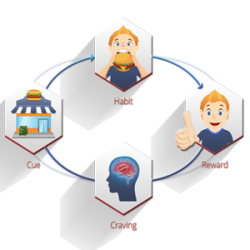
Manage Your Habit Loop
Module 4 of The Willpower Program
Since many of our goals involve either conquering unwanted existing habits, or adopting new habits, it is important that we understand what habits are.
Habits are procedural, non-declarative memories. They are automated, non-conscious behaviors, in which our conscious awareness is not involved. Neuroscientists have defined a model called “The Habit Loop” to describe our habitual behaviors.

The Habit Loop consists of the following four components:
1. The Cue. The cue is the stimulus that triggers the behavior. It could be an external stimulus such as something you see, hear, or smell. It could also be an internal stimulus such as a drop in blood sugar, an emotion, or a thought.
2. The Routine. This is the habitual behavior or routine that we execute in response to the cue. It could be reaching out for a piece of chocolate in response to a drop in our blood sugar, reaching out for a drink in response to a higher stress level at the end of the day, or going to the gym first thing every morning.
3. The Reward. Ultimately, this is the reason for performing the habitual routine. It could be the good feeling that a rise in blood sugar brings about, or the “high” that results from an intense workout at the gym.
4. The Craving. This is the Reward Anticipation Signal generated by our brain in response to the cue and in anticipation of the expected reward. In fact, our brain memorizes the satisfying sensation or feeling that results from the reward. It is our desire to experience this satisfying sensation or feeling that motivates us to execute the behavior in response to the cue.
Research:
Professor Wolfram Schultz of Cambridge University in the UK has studied extensively the brain activities of Macaque Monkeys while they were learning new habits. In his studies, he was able to determine how dopamine neurons, which are activated during the reward anticipation part of the Habit Loop, are inducing the habitual behavior of the monkeys. Professor Schultz’s work helped us understand how habits are formed in response to a promised reward.
In his book, The Power of Habit, Charles Duhigg describes the Habit Loop and how we can learn to overcome old undesired habits and adopt new healthier ones.
Practice Guidelines:
To acquire a new behavior that you want to habitualize, you have to design the Cue, Behavior, and Reward components of the Habit Loop.
You should then practice the new habit consistently for at least 8 weeks until it becomes automated behavior.


